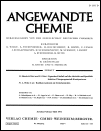The Preparation of Carbodiimides from Isocyantes†
Dr. W. Neumann
Wissenschaftliches Hauptlaboratorium and Zwischenprodukte-Abteilung, Farbenfabriken Bayer A.-G. Leverkusen (Germany)
Search for more papers by this authorDr. Peter Fisher
Wissenschaftliches Hauptlaboratorium and Zwischenprodukte-Abteilung, Farbenfabriken Bayer A.-G. Leverkusen (Germany)
Search for more papers by this authorDr. W. Neumann
Wissenschaftliches Hauptlaboratorium and Zwischenprodukte-Abteilung, Farbenfabriken Bayer A.-G. Leverkusen (Germany)
Search for more papers by this authorDr. Peter Fisher
Wissenschaftliches Hauptlaboratorium and Zwischenprodukte-Abteilung, Farbenfabriken Bayer A.-G. Leverkusen (Germany)
Search for more papers by this authorDedicated to Prof. Dr. Otto Bayer on the occasion of his 60th birthday.
Abstract
Carbodiimides are formed with simultaneous evolution of CO2 by the reaction of basic catalyst with sterically hindered isocynates. Another generally applicable synthesis of carbodiimides involves intermediate formation of cyclic adducts of isocyanates and carbodiimides, which, upon cleavage, exchange the isocyanate and carbodiimide functions. Both processes are suitable for the preparation of polycarboiimides. Several commercial applications of mono- and polycarbodiimides are pointed out.
References
- 1 Review: H. G. Khorana, Chem. Reviews 53, 145 (1953).
- 2 A. W. Hofmann, Ber. dtsch. chem. Ges. 18, 765 (1885); R. Stolle, Ber. dtsch. chem. Ges. 41, 1125 (1908).
- 3 T. W. Compbell and J. J. Verbanc, U.S. Pat. 2853473 (1956/1958); W. J. Balon, U.S. Pat. 2853518 (1956/1958). Compounds (1) and (2) are frequently called phospholines and phospholidines, respectively.
- 4 After the conclusion of our work, we found in a conference report [ Angew. Chem. 74, 127 (1962)] the statement that T. W. Campbell also observed the catalytic effect of non-cyclic phosphine oxides during the formation of carbodiimides from isocyanates.
- 5
A. W. Hofmann,
Ber. dtsch. chem. Ges.
18, 764
(1885);
10.1002/cber.188501801162 Google Scholarsee also J. H. Saunders and R. J. Slocombe, Chem. Reviews 43, 203 (1948).
- 6 The process is the subject of patents and patent applications, see e. g. W. Neumann, French Pat. 1293252 (1961/1962).
- 7 Aromatic o-alkylamines are easily accessible by the reaction of olefins with aromatic amines: R. Stroh et al., Angew. Chem. 69, 124 (1957).
- 8 We thank Dr. W. Siefken (Wissenschaftliches Hauptlaboratorium der Farbenfabriken Bayer AG.) for the preparation of several isocyanates used in this work.
- 9 According to a paper published after our patent application, carbodiimides are formed, in addition to derivatives of isocyanuric acid, by the reaction of metal naphthenates and aluminum isopropoxide with 1-naphthylisocyanate and diphenylmethane-4,4′-diisocyanate: E. Dyer and E. E. Read, J. org. Chemistry 26, 4677 (1961).
- 10 H. G. Khorana [1]: Polymeric carbodiimides are formulated as dimeric or trimeric compounds, in analogy to the uretidinediones and derivatives of isocyanuric acid in the isocyanate series.
- 11 We thank Prof. Dr. M. Pestemer, Dr. D. Lauerer, and Dr. H. Hoyer (Wissenschaftliches Hauptlaboratorium und Organischanalytisches Laboratorium der Farbenfabriken Bayer AG.) for the infrared absorption spectra and their discussion.
- 12 H. G. Khorana [1].
- 13
F. Zetsche and
H. Lindlar,
Ber. dtsch. chem. Ges.
71, 2095
(1938).
10.1002/cber.19380711018 Google Scholar
- 14 G. Gaylor and J. A. Snyder, Chem. and Ind. 1955, 145.
- 15 H. Staudinger: Die Ketene. F. Enke Verlag, Stutgart 1912, p. 126; see also H. D. Piepenbrink in: Houben-Weyl: Methoden der organischen Chemie. 4th Edit., G. Thieme Verlag, Stuttgart 1952, vol. 8, p. 220.
- 16 C. J. Bowen, J. Chem. Soc. (London) 1955, 2931.
- 17 H. F. Piepenbrink in: Houben-Weyl: Methoden der organischen Chemie. 4th Edit., G. Thieme Verlag, Stuttgart 1952, Vol. 8, p. 220; see also W. Balon et al.: Papers presented at the Atlantic City Meeting, September 1956; Symposium on Isocyanate Polymers. Amer. chem. Soc., Div. of Paint, Plastics and Printing Ink Chemistry, vol. 16, p. 69.
- 18 For the addition of phenyl isocyanate onto Michler's ketone and onto p-nitrosodimethylaniline Staudinger assumes a primary addition product in the form of the same four-membered ring as formulated here; the assumption is based on the cleavage products: H. Staudinger [15], p. 125.
- 19 K. H. Slotta and R. Tschesche, Ber. dtsch. chem. Ges. 60, 295 (1927).
- 20 Polycarbodiimides must be differentiated from polymeric carbodiimides (see [10]).
- 21 E. Dyer and G. E. Newborn, J. Amer. chem. Soc. 80, 5495 (1958).
- 22 P. Fischer and E. Meisert, German Patent 1092007 (1959/1960).
- 23 T. W. Campbell and J. J. Verbanc [3]; T. W. Campbell, U.S. Patent 2941966 (1956/1960); K. C. Smeltz, U.S. Patent 2941 983 (1957/1960); see also T. W. Campbell, Angew. Chem. 74, 127 (1962).
- 24 R. Hofmann, E. Schmidt, A. Reichle and F. Moosmüller, German Patent 1 012 601 (1955/1957).
- 25 P. Fischer, German Patent 1 122 057 (1960/1962).
- 26 K. Wagner, Angew. Chem. 74, 799 (1962).
- 27 H. Holtschmidt et al., German Patent 1 005 726 (1955/1957).
- 28 The use of sterically hindered carbodiimides as aging inhibitors is the subject of patents and patent applications, see e.g. W. Neumann, Belg. Pat. 610 969 (1961/1962) and 612 040 (1961/1962). For details concerning commercial applications, see W. Neumann, et al.: Proc. 4th Rubber Technology Conf., London 1962, in the press.




